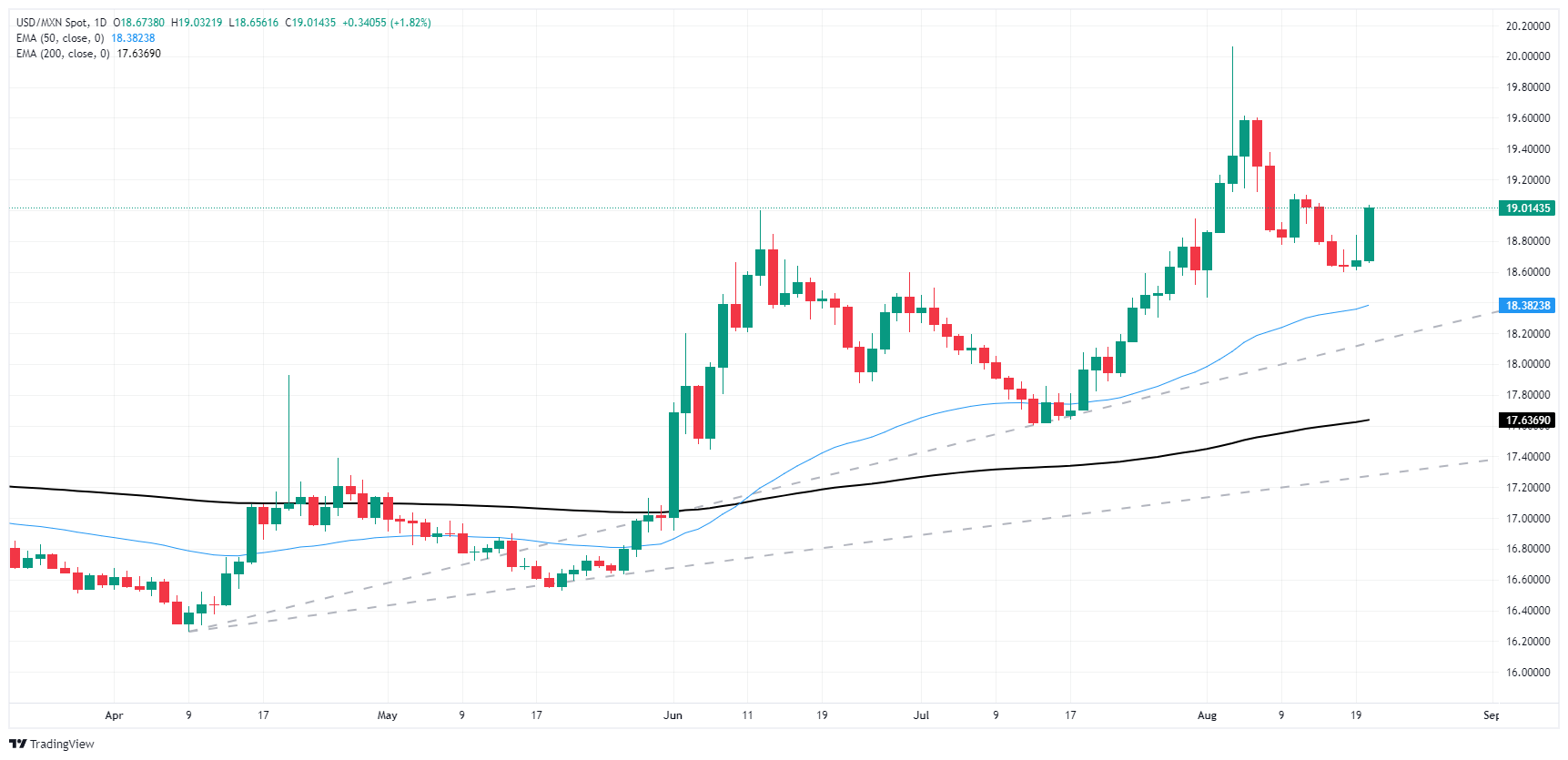- Analiza
- Novosti i instrumenti
- Vesti sa tržišta
- Mexican Peso falls back after Mexico Retail Sales misfire
Mexican Peso falls back after Mexico Retail Sales misfire
- The Mexican Peso shed 1.8% against the Greenback on Tuesday.
- Mexico saw a much steeper contraction in Retail Sales than expected.
- Markets are looking for signs of Fedspeak ahead of Jackson Hole.
The Mexican Peso (MXN) took a step back against the US Dollar on Tuesday after a miss in Mexican Retail Sales. Markets continue to tilt towards the Jackson Hole Economic Symposium later this week, looking for signs of a Federal Reserve (Fed) rate cut in September.
Daily digest market movers: Mexico Retail Sales sputter sends Peso lower
- Mexico reported a wide miss in Retail Sales, which contracted twice as much as expected in June.
- Mexican Retail Sales contracted 3.9% for the year ended in June, far below the forecast -1.8% and tumbling back from the previous month’s 0.3% uptick.
- MoM Mexico Retail Sales also fell back 0.5%, underperforming the previous print of 0.1%.
- Fedspeak will have a pronounced impact on market flows in the coming days as investors gear up for the Jackson Hole kickoff on Thursday.
- Global markets are broadly expecting the Fed to jumpstart a rate cutting cycle with at least a quarter-point rate trim on September 18.
Mexican Peso price forecast: USD/MXN jumps on Peso weakness
USD/MXN chalked in a 1.8% upswing on Tuesday as the Peso stumbles against the Greenback. Despite a broad-market pullback in the US Dollar Index, USD/MMXN is still finding higher ground and testing beyond the 19.00 handle.
With the pair poised for a near-term upswing, bidders are looking to extend topside momentum and mark in another higher lower on daily candlesticks.
USD/MXN daily chart
Mexican Peso FAQs
The Mexican Peso (MXN) is the most traded currency among its Latin American peers. Its value is broadly determined by the performance of the Mexican economy, the country’s central bank’s policy, the amount of foreign investment in the country and even the levels of remittances sent by Mexicans who live abroad, particularly in the United States. Geopolitical trends can also move MXN: for example, the process of nearshoring – or the decision by some firms to relocate manufacturing capacity and supply chains closer to their home countries – is also seen as a catalyst for the Mexican currency as the country is considered a key manufacturing hub in the American continent. Another catalyst for MXN is Oil prices as Mexico is a key exporter of the commodity.
The main objective of Mexico’s central bank, also known as Banxico, is to maintain inflation at low and stable levels (at or close to its target of 3%, the midpoint in a tolerance band of between 2% and 4%). To this end, the bank sets an appropriate level of interest rates. When inflation is too high, Banxico will attempt to tame it by raising interest rates, making it more expensive for households and businesses to borrow money, thus cooling demand and the overall economy. Higher interest rates are generally positive for the Mexican Peso (MXN) as they lead to higher yields, making the country a more attractive place for investors. On the contrary, lower interest rates tend to weaken MXN.
Macroeconomic data releases are key to assess the state of the economy and can have an impact on the Mexican Peso (MXN) valuation. A strong Mexican economy, based on high economic growth, low unemployment and high confidence is good for MXN. Not only does it attract more foreign investment but it may encourage the Bank of Mexico (Banxico) to increase interest rates, particularly if this strength comes together with elevated inflation. However, if economic data is weak, MXN is likely to depreciate.
As an emerging-market currency, the Mexican Peso (MXN) tends to strive during risk-on periods, or when investors perceive that broader market risks are low and thus are eager to engage with investments that carry a higher risk. Conversely, MXN tends to weaken at times of market turbulence or economic uncertainty as investors tend to sell higher-risk assets and flee to the more-stable safe havens.
© 2000-2024. Sva prava zaštićena.
Sajt je vlasništvo kompanije Teletrade D.J. LLC 2351 LLC 2022 (Euro House, Richmond Hill Road, Kingstown, VC0100, St. Vincent and the Grenadines).
Svi podaci koji se nalaze na sajtu ne predstavljaju osnovu za donošenje investicionih odluka, već su informativnog karaktera.
The company does not serve or provide services to customers who are residents of the US, Canada, Iran, The Democratic People's Republic of Korea, Yemen and FATF blacklisted countries.
Izvršenje trgovinskih operacija sa finansijskim instrumentima upotrebom marginalne trgovine pruža velike mogućnosti i omogućava investitorima ostvarivanje visokih prihoda. Međutim, takav vid trgovine povezan je sa potencijalno visokim nivoom rizika od gubitka sredstava. Проведение торговых операций на финанcовых рынках c маржинальными финанcовыми инcтрументами открывает широкие возможноcти, и позволяет инвеcторам, готовым пойти на риcк, получать выcокую прибыль, но при этом неcет в cебе потенциально выcокий уровень риcка получения убытков. Iz tog razloga je pre započinjanja trgovine potrebno odlučiti o izboru odgovarajuće investicione strategije, uzimajući u obzir raspoložive resurse.
Upotreba informacija: U slučaju potpunog ili delimičnog preuzimanja i daljeg korišćenja materijala koji se nalazi na sajtu, potrebno je navesti link odgovarajuće stranice na sajtu kompanije TeleTrade-a kao izvora informacija. Upotreba materijala na internetu mora biti praćena hiper linkom do web stranice teletrade.org. Automatski uvoz materijala i informacija sa stranice je zabranjen.
Ako imate bilo kakvih pitanja, obratite nam se pr@teletrade.global.















